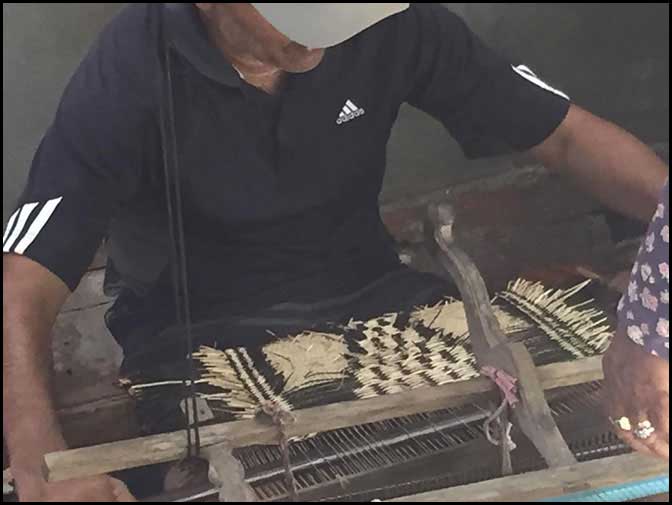 |













Three types of weaving techniques exist in Huvadhoo. The bobbin weaving of narrow bands of color strips used as the decorative application on the upper parts of the women’s national dress. Second was the mat weaving, and third the textile weaving.
1) Bobbin (lace) weaving in Thinadoo: We visited the home of a weaver who demonstrated to us how she weaves the ribbon strips by hand. This method is used by weavers in Thinadoo island to make narrow bands of ribbons called kasabu that are used to attach onto the traditional dress called kasabu libas. A large rounded stuffed cushion support is placed on a turned lacquer work wood base, and this is what the weaver works from the top of this cushion to wind the bobbin threads back and forth to make the design on the ribbon. Gold and metallic colored threads are popular on this island. The strip of ribbon is about ½ inch to 1 ½ inch in width, and these bands of ribbon are then attached to the neck and upper parts of the libas dress. This is a three quarter length dress worn over a longer solid color skirt. The threads used come from Trivandrum, Kerala, India. They continue to import these thread that are used for the kasabu weaving. The museum in Thinadoo has images of the kasabu libas, and another lacquer wood cylinder support and cushion used for the weaving.
Note: In Sri Lanka this form of bobbin weaving is still practiced and was introduced during the Portuguese and Dutch colonial periods. The weaving technique utilizing several bobbins wrapped with a strong white cotton thread and called bobbin lace was used to weave various strips of fine lace with fine to medium think cotton threads that are used trim the neck and sleeves of women’s garments and used as border edgings on doilies and tablecloths.
2) Mat weaving: Thundu Kunaa mats from South Huvadhoo Atoll.
In Ghaddhoo island we visited the home of the principal weaver and National Award winner for mat weaving. Her name is Mariam Faiza. Two others were also there, Amisa Mohamed (who also won a National Award) and Aminah Wahida an experienced weaver. The ladies demonstrated the process and weaving technique to the research team and then brought out various pieces of woven mats for us to examine and document. The larger mats were used as a covering over surface for the traditional swing beds that are strung with fine coir rope, and are seen in most homes.
These mats can be used daily and are long lasting. The mat is woven on a special mat-weaving loom and the weaving is done on the reverse. My images and videos will show you the process. Details of the craft, materials, natural dyes and technique of reverse weaving is found in the booklet by MACCS and website.
For further eference:
The Production & Design of Thundu Kunaa Mats in Huvadu Atoll, edited by Aminath Abdulla, produced by MACCS - Maldives Authentic Crafts Cooperative Society, 2017]
https://www.goodmarket.global/maccs, and https://www.unesco-ichcap.org/mat-weaving-in-the-maldives.
The Maldivian coir rope making has been practiced for centuries, and associated in seafaring and boatbuilding. The finest coir for marine use is Maldivian. For reference see coir rope making in the Maldives. For furtherreference:
https://www.themaldivesexpert.com/1910/the-art-of-coir-rope-making.
3) Handloom weaving was done in the Maldives. We visited a family who had an old loom that was made in India. The weaver who was a man had died and the loom was not used after this. We documented the loom and some pieces of fabric that had been woven by the weaver. No one in his family was interested in being a weaver.
